| Columns Retired Columns & Blogs |
Bryston B100-DA SST DAC/integrated amplifier Measurements
Sidebar 3: Measurements
Footnote 1: That this is higher than the 137W measured by Bryston's tech is most probably due to my AC line voltage being higher.
Because the Bryston B100-DA has a D/A section and offers both preamplifier output and power-amplifier input jacks, it's really three products in one. (The review sample was not fitted with the phono option.) I performed a full set of measurements on each section and also on the amplifier as a whole. I preconditioned the B100-DA by running it for 60 minutes at one-third power into 8 ohms, which is the worst case for an amplifier with a class-B output stage. At the end of that time the heatsink was way too hot to touch, and even the front panel was hot. The amplifier didn't turn off, however, and the THD+noise percentage was the same at the end of that time as it had been at the beginning: 0.0059%.
I began by examining the D/A section's performance at the preamplifier output jacks. With the volume control at its maximum, a 1kHz tone at 0dBFS resulted in an output of 10.75V, well above the level needed to drive a power amplifier to its maximum. With the volume control at 12:00, the output was 757mV. The digital section was non-inverting; ie, it preserved absolute polarity. The digital input locked on to data sampled up to 96kHz, and fig.1 shows the digital frequency response at –12dBFS with both 44.1kHz and 96kHz sample rates. The latter is flat to 40kHz, with then a sharp rolloff to –3dB at 46kHz. Channel separation via the digital input (not shown) was superb, at better than 120dB across most of the audioband.
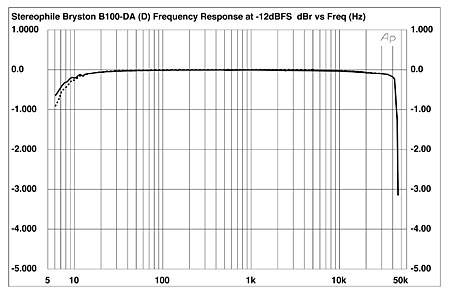
Fig.1 Bryston B100-DA, digital frequency response at –12dBFS into 100k ohms with 44.1kHz and 96kHz sample rates (right channel dashed, 0.5dB/vertical div.).
Digital resolution was equivalent to around 18 bits. The top trace in fig.2 shows a spectral analysis of the B100-DA's preamp output while it decoded data representing a dithered 1kHz tone at –90dBFS. The trace peaks at exactly –90dBFS, and other than some low-level, power-supply–related spuriae at 60Hz and 120Hz, the noise floor is that of the recorded dither noise. Increasing the word length to 24 bits drops the noise by a good 12dB in the midrange and treble, though this unmasks another supply-related peak, at 240Hz. Repeating the analysis over a wider bandwidth with the B100-DA fed data representing 24-bit digital black again revealed the low level of audioband noise, but with a rising ultrasonic content due to the noiseshaping used by the DAC chip to achieve its resolution (fig.3).
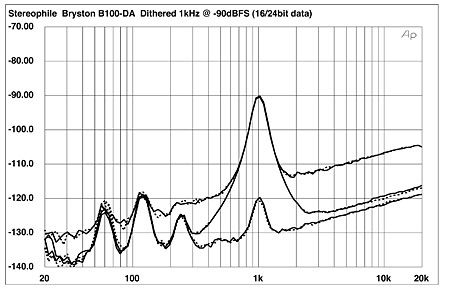
Fig.2 Bryston B100-DA, 1/3-octave spectrum with noise and spuriae of dithered 1kHz tone at –90dBFS, 16-bit data (top) and 24-bit data (bottom). (Right channel dashed.)
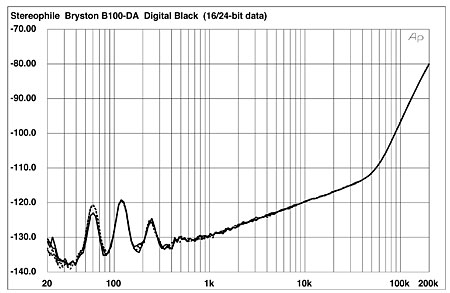
Fig.3 Bryston B100-DA, 1/3-octave spectrum with noise and spuriae of digital black, 24-bit data (right channel dashed).
Linearity error assessed with 16-bit data really shows only the effect of the recorded dither (fig.4), while the Bryston's reproduction of undithered data representing a 1kHz tone at exactly –90.31dBFS was essentially perfect with both 16-bit data (fig.5) and 24-bit data (Fig.6).
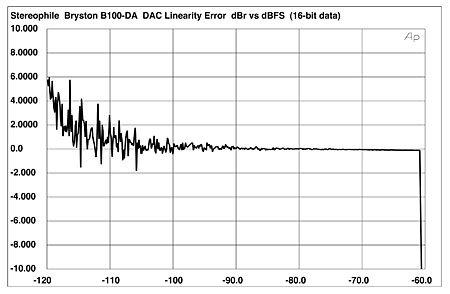
Fig.4 Bryston B100-DA, left-channel departure from linearity, 16-bit data (2dB/vertical div.).
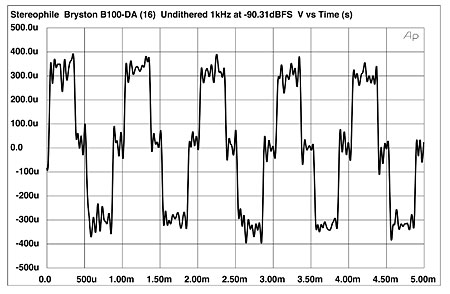
Fig.5 Bryston B100-DA, waveform of undithered 1kHz sinewave at –90.31dBFS, 16-bit data.
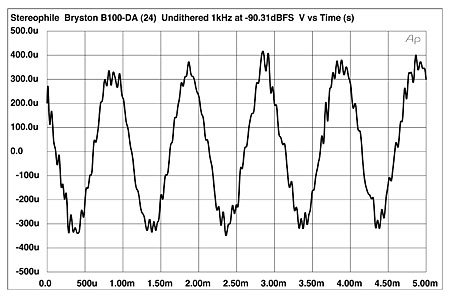
Fig.6 Bryston B100-DA, waveform of undithered 1kHz sinewave at –90.31dBFS, 24-bit data.
The B100-DA was also excellent when it came to rejecting word-clock jitter, even via its TosLink optical input. Fig.7, taken with the Miller Audio Research Jitter Analyzer, shows a narrowband spectral analysis of the Bryston's preamplifier output while it decoded 16-bit data representing a high-level tone at exactly one quarter the sample rate, over which had been laid the LSB toggling on and off at exactly 1/192 the sample rate—very much a worst-case test. Even so, the jitter level was just 182.7 picoseconds peak–peak, with data-related sidebands (red numeric markers) almost at the residual level of the test signal. Most of the jitter comes from a sideband pair at ±15.6Hz, but some spectral spreading of the peak representing the 11.025kHz tone can also be seen, suggesting the presence of some random low-frequency jitter.
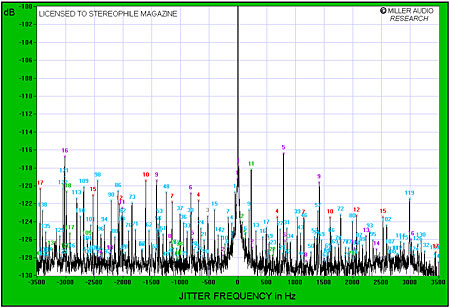
Fig.7 Bryston B100-DA, high-resolution jitter spectrum of analog output signal (11.025kHz at –6dBFS sampled at 44.1kHz with LSB toggled at 229Hz), 16-bit data sourced from PC with RME soundcard and TosLink connection. Center frequency of trace, 11.025kHz; frequency range, ±3.5kHz.
Turning to the Bryston's preamplifier section, this too preserved absolute polarity for analog input signals, and had a usefully high input impedance of 49k ohms at low and midrange frequencies, this dropping inconsequentially to 45k ohms at 20kHz. Voltage gain with the volume control set to its maximum was a sensible 12.1dB, while the unity-gain setting was 2 o'clock. The output impedance for the preamp jacks was a low 75 ohms at midrange and high frequencies, increasing to 102 ohms at 20Hz, which resulted in a slight infrasonic rolloff when the frequency response was measured into the punishing 600 ohm load (fig.8, bottom pair of traces below100Hz). Into 100k ohms (fig.8, top traces), the preamp response was flat in the audioband, rolling off at ultrasonic frequencies to –3dB at 142kHz. This graph was taken with the volume control set to its maximum; with it set to 12 o'clock, the bandwidth increased very slightly, to –3dB at 156kHz, but the superb channel matching seen in fig.8 didn't change.
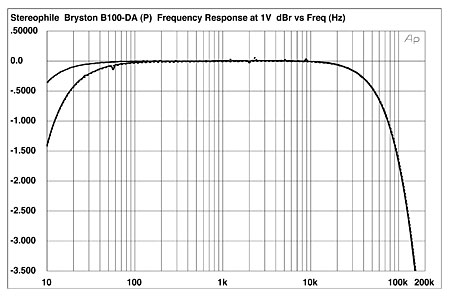
Fig.8 Bryston B100-DA, preamplifier frequency response at 1V into (from top to bottom at 20Hz): 100k, 600 ohms (0.5dB/vertical div., right channel dashed).
Channel separation was superb, at better than 110dB in both directions below 4kHz (not shown), and the B100-DA's preamp section could also output very high levels without distortion. Even into 600 ohms, the Bryston preamp section didn't clip (defined as a THD+N level of 1%) until almost 12V RMS (fig.9, top trace). The fact that the traces in this graph slope upward below 2V suggests that the preamplifier's distortion remains below the noise floor at all levels that will be encountered in practical use.
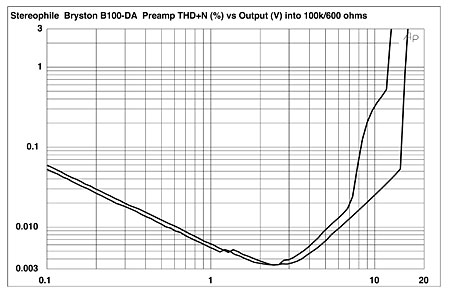
Fig.9 Bryston B100-DA, THD+noise (%) vs 1kHz output voltage into (from bottom to top): 100k, 600 ohms.
Turning to the power-amplifier section, the input impedance was a low 10k ohms at all audio frequencies, and this section, too, preserved absolute polarity. The voltage gain into 8 ohms was 29dB, resulting in an overall maximum gain for the B100-DA of 41dB. The output impedance was a very low 0.07 ohm at low and midrange frequencies (including 6' of speaker cable), rising very slightly to 0.1 ohm at 20kHz. As a result, the modification of the amplifier's response by the usual Ohm's Law interaction between the source impedance and the way in which the impedance of our standard simulated speaker load changes with frequency was negligible (fig.10, top trace at 2kHz). Fig.10 shows that while the amplifier's bandwidth did decrease slightly into lower impedances, it was still wide overall, at –3dB at 100kHz into 8 ohms. As a result, the Bryston's reproduction of a 10kHz squarewave featured short risetimes (fig.11), but with a very slight uptilt of the waveform tops, this correlating with the very slight frequency-response plateau apparent in fig.10 just before the high-frequency rolloff.
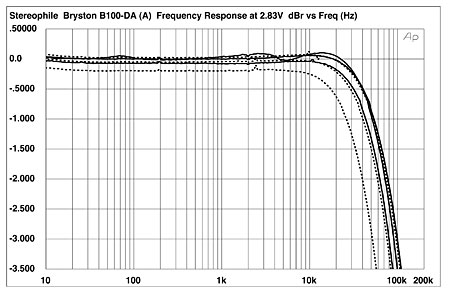
Fig.10 Bryston B100-DA, frequency response at 2.83V into (from top to bottom at 2kHz): simulated loudspeaker load, 8, 4, 2 ohms (0.5dB/vertical div.).
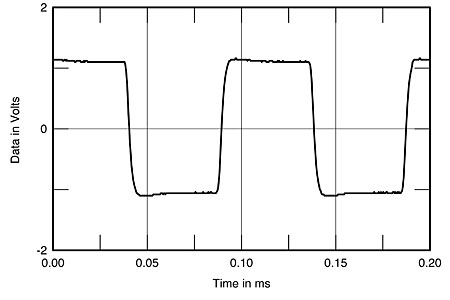
Fig.11 Bryston B100-DA, small-signal 10kHz squarewave into 8 ohms.
The amplifier's channel separation was again superb, at better than 110dB below 3kHz, but capacitive coupling reduced this to a still excellent 94dB in both directions at 20kHz. The unweighted, wideband signal/noise ratio, with the input shorted ref. 2.83V into 8 ohms, was an excellent 84.4dB, this improving to 93.5dB when A-weighted.
With one channel driven, the B100-DA easily exceeded its specified output powers of 100W into 8 ohms (20dBW) and 180W into 4 ohms (19.55dBW). With clipping defined as 1% THD+N, the Bryston clipped at 148W into 8 ohms (footnote 1) (21.7dBW) and 200W into 4 ohms (20dBW). The B100-DA is not rated into 2 ohms, but fig.12 shows that it delivered 102W into that impedance (14.1dBW).
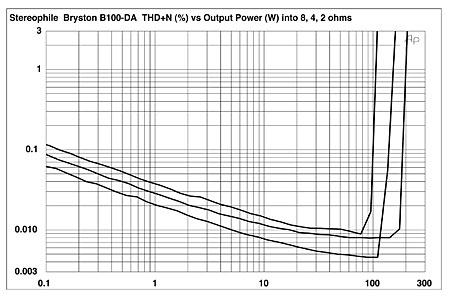
Fig.12 Bryston B100-DA, distortion (%) vs 1kHz continuous output power into (from bottom to top at 100W): 8, 4, 2 ohms.
The downward slopes of the traces in fig.12, which were taken with a 1kHz tone, suggest that the distortion lies beneath the amplifier's noise floor at almost all power levels. I therefore plotted the Bryston's THD+N percentage against frequency at a fairly high level: 9V, or the equivalent of 10W into 8 ohms. The results are shown in fig.13; the measured distortion below 1kHz or so is actually noise, which is why it doesn't change as the load impedance drops. However, the distortion does rise above 1kHz and into lower impedances, though not to a significant level.
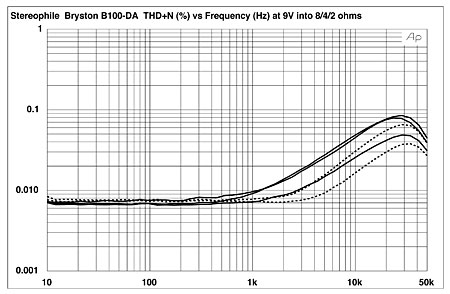
Fig.13 Bryston B100-DA, THD+N (%) vs frequency at 9V into (from bottom to top): 8, 4, 2 ohms.
The content of that distortion is predominantly third harmonic (fig.14, with 32 readings averaged to reduce the effect of noise on the oscilloscope trace), though the THD is very low in level even at powers approaching clipping (fig.15). Intermodulation distortion was also very low, even at a power level just below visible clipping on the 'scope screen (fig.16).
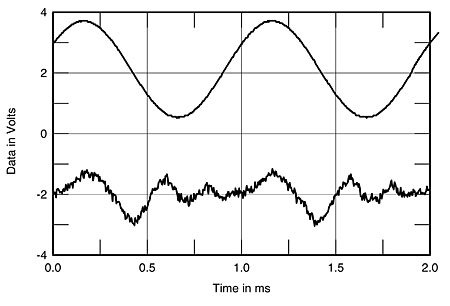
Fig.14 Bryston B100-DA, 1kHz waveform at 25W into 8 ohms (top), 0.0084% THD+N; distortion and noise waveform with fundamental notched out (bottom, not to scale).
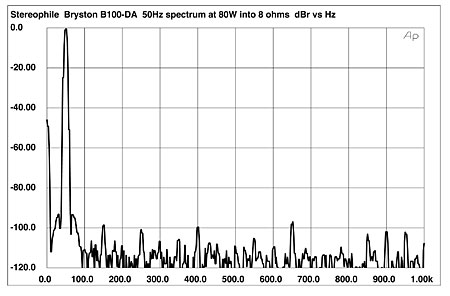
Fig.15 Bryston B100-DA, spectrum of 50Hz sinewave, DC–1kHz, at 80W into 8 ohms (linear frequency scale).
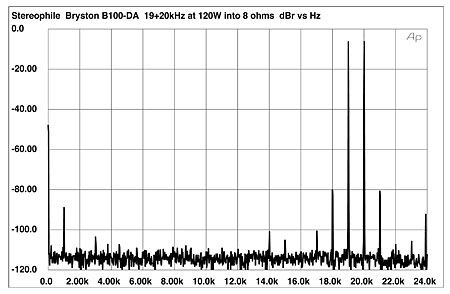
Fig.16 Bryston B100-DA, HF intermodulation spectrum, DC–24kHz, 19+20kHz at 120W peak into 8 ohms (linear frequency scale).
The Bryston B100-DA offers a lot of functionality for a relatively modest price. Commendably, its performance has not been compromised in any one area to achieve that functionality. The amplifier should not be used by those wanting to play their music at high powers with loudspeakers whose impedance drops much below 4 ohms, but that's not really a significant limitation. I was impressed by what I found.—John Atkinson
Footnote 1: That this is higher than the 137W measured by Bryston's tech is most probably due to my AC line voltage being higher.
- Log in or register to post comments




































